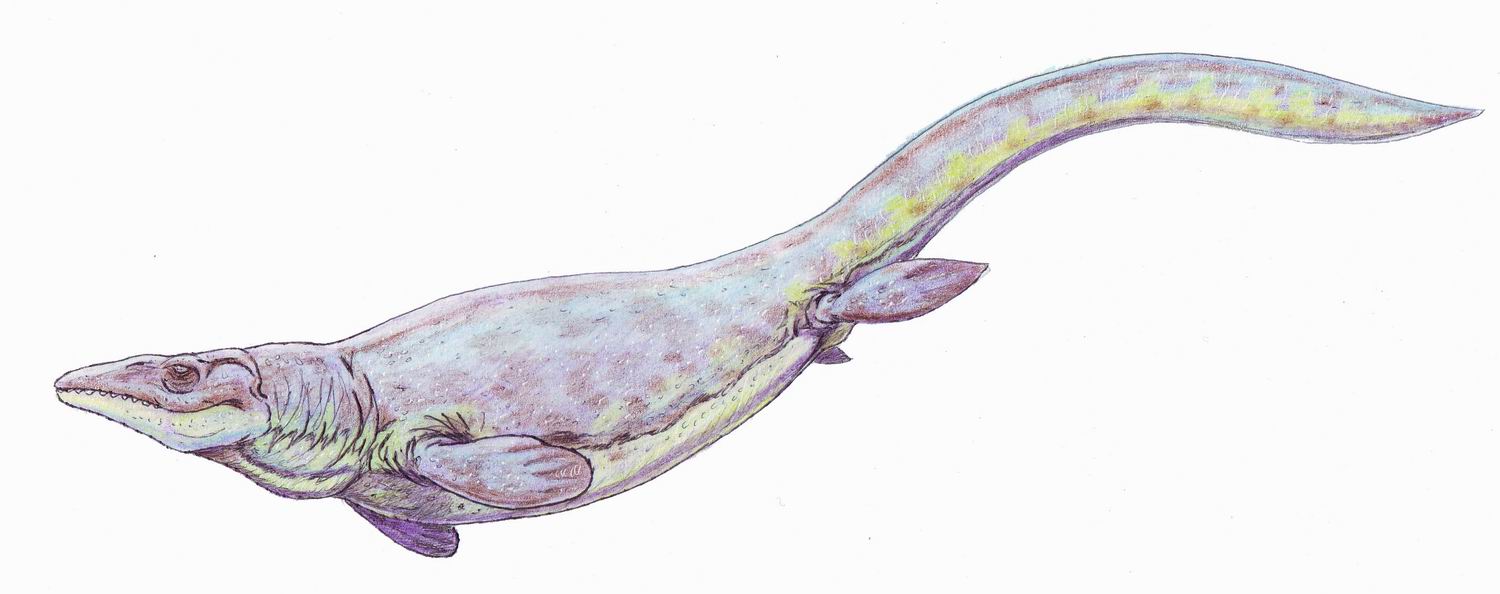- Globidens
Taxobox
name = "Globidens"
fossil_range =Late Cretaceous 
image_caption = "G. alabamaensis".
image_width = 250px
regnum =Animal ia
phylum = Chordata
classis = Sauropsida
ordo =Squamata
subordo =Scleroglossa
familia =Mosasauridae
subfamilia =Mosasaurinae
tribus =Globidensini
genus = "Globidens"
genus_authority = Gilmore, 1912
subdivision_ranks = Species
subdivision =
* "G. alabamaensis" (Type )
Gilmore, 1912
* "G. dakotensis" Russell, 1975
* "G. aegypticus" Zdansky, 1935
* "G. timorensis" Huene, 1935
* "G. schurmanni" Martin, 2007"Globidens" ("Globe teeth") is an
extinct genus ofmosasaur lizard ."Globidens alabamaensis" was first described by Gilmore (1912). A second species ("G. dakotensis") was described by Russell (1975). The third North American species ("G. schurmanni") was added by Martin (2007)
"Globidens" was ~6 m (20 ft) in length and in appearance very much like other mosasaurs (streamlined body with flippers, a laterally flattened
tail and powerfuljaw s). Theteeth of "Globidens" were vastly different from other mosasaurs, as they were globular, as suggested in its generic name. Generally, most mosasaurs had sharp teeth evolved to grab soft, slippery prey likefish andsquid , which, in later species, were later modified to rend flesh, as well. While many other mosasaurs were capable of crushing the shells of ammonites, none were as specialized in dealing with armored prey like "Globidens". "Globidens", unlike most other mosasaurs, had semispherical teeth with roundednubbin -like points, which were much better suited for crushing tough armored prey like smallturtle s,ammonite s, nautili, andbivalve s. Like its larger relative, "Mosasaurus ", "Globidens" had a robustly built skull with tightly-articulating jaws. Such features no doubt played a large role in its ability to penetrate the armor of its shelled prey.The smaller genus "
Carinodens " is regarded as a sister taxon of "Globidens".References
* Bardet, N., Pereda Suberbiola, X., Iarochène, M., Amalik M., and Bouya, B. 2005. Durophagous Mosasauridae (Squamata) from the Upper Cretaceous phosphates of Morocco, with description of a new species of "Globidens". Netherlands Journal of Geosciences / Geologie en Mijnbouw, 84(3), p. 167-176.
* Everhart, M.J. 2008. Rare occurrence of a "Globidens" sp. (Reptilia; Mosasauridae) dentary in the Sharon Springs Member of the Pierre Shale (Middle Campanian) of Western Kansas. p. 23-29 in Farley G. H. and Choate, J.R. (eds.), Unlocking the Unknown; Papers Honoring Dr. Richard Zakrzewski, , Fort Hays Studies, Special Issue No. 2, 153 p., Fort Hays State University, Hays, KS.
* Gilmore, Charles W. 1912. A new mosasauroid reptile from the Cretaceous of Alabama, Proceedings U.S. National Museum, 40(1870): 489-484, 3 fig., pl. 39-40 (Description of "Globidens alabamaensis" type)
* Huene, E. von. 1935. Mosasaurier-Zähne von Timor. Centralblatt fur Mineralogie. Geologic und Palaeontologie; in Verbindung mit dens Neuen Jahrbuch fur Mineralogie, Geologie und Palaeontologie. Stuttgart. Abt. B 10 412-416, 3 figs. (in German)
* Martin, J. E. 2007. A new species of the durophagous mosasaur, "Globidens" (Squamata: Mosasauridae) from the Late Cretaceous Pierre Shale Group of central South Dakota, USA. Pages 167-176 in Martin, J. E. and Parris D. C. (eds.), The Geology and Paleontology of the Late Cretaceous Marine Deposits of the Dakotas. Geological Society of America, Special Paper 427. ("Globidens schurmanni")
* Russell, Dale A. 1975. A new species of "Globidens" from South Dakota. Fieldiana Geology, 33(13): 235-256. (Field Museum of Natural History)
* Zdansky, O. 1935. The occurrence of mosasaurs in Egypt and in Africa in general. Bulletin de l’Institut d’Egypte 17: 83-94.
Wikimedia Foundation. 2010.
